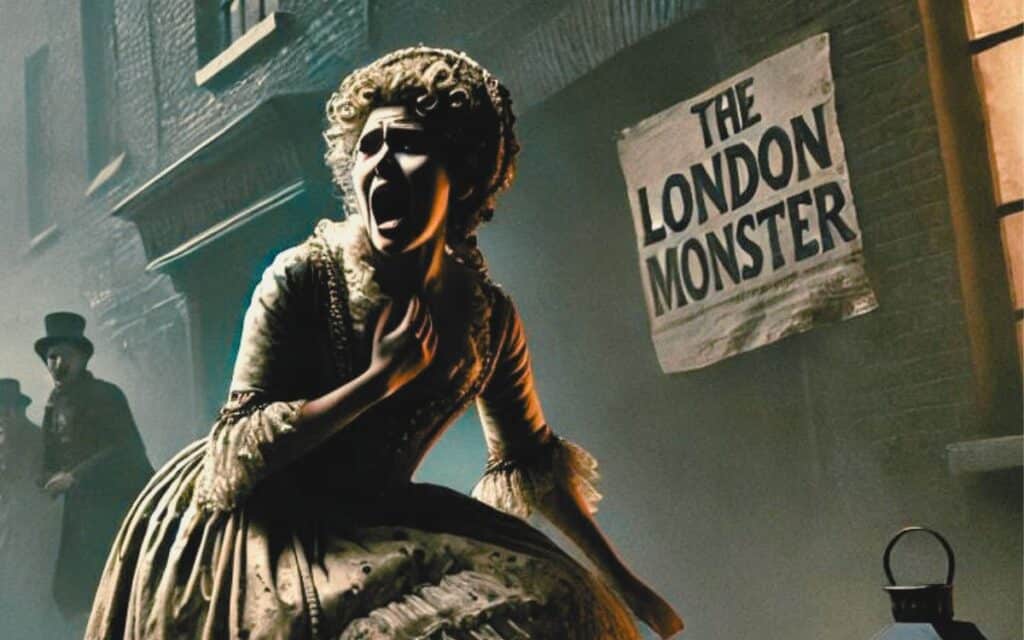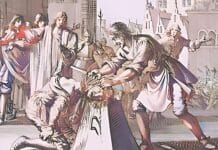In the late 18th century, the “London Monster” terrorised women, causing mass hysteria and a controversial conviction, writes RICHARD CLEMENTS

In the late 18th century, London’s streets became a battleground for fear and paranoia as a shadowy figure known as the “London Monster” unleashed a bizarre and terrifying crime spree.
Between 1788 and 1790, an unidentified assailant stalked the streets, insulting and stabbing the petticoats and flesh of well-to-do ladies with sharp objects before slipping away into the night.
Though none were killed, over 50 victims fell prey to this mysterious perpetrator, soon dubbed the “London Monster” by the sensationalist newspapers of the day. What followed was a phenomenon of mass hysteria, moral panic, and a desperate search for a culprit at any cost.
The Attacks and Rising Terror
The first reported strike by the so-called Monster came in 1788 in the West End. A large man approached a lone woman on the street, shouting obscenities before stabbing her in the buttocks with a knife and fleeing as she cried for help.
Over the next two years, the attacks escalated in boldness and frequency across the city. The assailant’s methods varied—some victims described knives fastened to his knees to slice at their skirts, while others recounted being invited to smell a nosegay only to be stabbed in the face by a concealed stiletto within the bouquet.
As more genteel young ladies fell victim, mass panic enveloped London’s streets. Women began donning cumbersome protective garments like copper petticoats or cork padding beneath their gowns to deter the Monster’s blades. Vigilante groups and amateur “Monster hunters” prowled the streets, while rewards topping £100 were offered for capturing the fiend. The desperate climate fuelled paranoia and false accusations against any man perceived as vaguely suspicious.
Fanning the flames of the growing “Monster mania” were London’s raucous newspapers and pamphleteers. Lurid accounts and satirical prints of rounded female bottoms proliferated, playing up each new attack with sensational language portraying the culprit as a sadistic misogynist or supernatural threat. Some reports alleged the Monster was a syndicate disguising his appearance; others suggested he may not exist at all beyond the realms of urban legend. A handful of swindlers even faked attacks to gain infamy and inflame tensions further.
As pressure mounted on authorities, the fledgling Bow Street Runners police force papered London with attention-grabbing posters warning of the “bloodthirsty” and “inhuman” Monster still at large. They urged servants and washerwomen to check men’s handkerchiefs for bloodstains, further feeding the media circus in its desperate demands for the fiend’s capture.
A Dubious Arrest and Trials
In June 1790, a suspect was finally apprehended. Rhynwick Williams, a 23-year-old unemployed son of a Welsh apothecary, was seized by a mob after Anne Porter, one of the earlier victims, identified him as the Monster. Though other accounts contradicted Porter’s claim, the meek Williams was promptly charged on her testimony alone.
What followed were two farcical trials mired in chaos, conflicting witness statements, and dubious legal manoeuvrings. Unable to charge Williams with assault due to the crime’s relatively light sentence, prosecutors tried him under an ancient statute about maliciously destroying clothing. His initial conviction on these grounds was overturned, while his second trial defence, led by the erratic poet Theophilus Swift, accused Porter of a ploy to claim the reward money after marrying her fiancé, who had turned Williams over to police.
In the fevered climate, substantive evidence seemed irrelevant. Despite alibi witnesses placing him at work during attacks and the contradictory physical descriptions offered of the Monster, Williams was found guilty and sentenced to six years imprisonment. Though the trials gave the illusion of resolving the crisis, reports of further Monster strikes persisted well after Williams’ incarceration.
A Modern Retrospective of The London Monster
With nearly two centuries of hindsight, historians have re-examined the London Monster case as a classic example of “phantom attacker” mass hysteria and delusion. Some experts note that an initial real perpetrator may have spurred copycat crimes in the absence of competent policing, but many argue that no single Monster likely existed beyond the public’s panicked imagination.
The fevered affair aligns strikingly with more recent cases like the purported Halifax Slasher of 1938, where many “victims” were found to have self-inflicted injuries for attention. It mirrors the 2001 Delhi “Monkey-Man” scare, which saw injuries faked amidst reports of an urban legend come to life attacking locals. Just as these modern cases revealed collective paranoia detached from evidence, the Monster panic seems rooted in a perfect storm of societal fear, rabid sensationalism, incompetent investigations, and a desperate need to condemn a scapegoat at any cost, regardless of reasonable doubt.
The reign of terror brought by the so-called London Monster stands as one of the earliest recorded examples of mass panic and phantom attacker syndrome. Though potentially arising from a number of initial criminal assaults, the public frenzy morphed into a self-perpetuating myth amid botched investigations and fevered press campaigns demanding a villain’s capture.
Fuelled by fear of the unknown, a need for a scapegoat, and a thirst for lurid scandal, the Monster case became a runaway spectacle of delusion outstripping reality. The enduring question remains whether the real crime lay in the shadowy attacks, or in society’s response, constructing a phantom menace of its own.
Tell us your thoughts on the London Monster in the comments section below!







